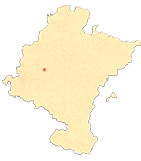La Portada de San Miguel de Estella
Eardrum
Romanesque portals reserve the tympanum for the main topic, in this case the glory of the second coming of Jesus Christ, a version of the vision described in the Apocalypse. Christ in majesty occupies the centre. Everything about him manifests his being and power: the cruciferous nimbus that identifies him, the serene face with long parted hair, the throne whose arms end in lion's heads and whose paws end in claws, the solemn gesture, the quality of the attire, and so on. The passing of the centuries have broken several fingers on his right hand, making it difficult to recognise details of the blessing. With his left hand he holds the crossed chrism resting on his knee. It is framed by a lobed mandorla with registration, which we will deal with in detail, and flanked by the four figures of the tetramorph, symbols of the evangelists, as evidenced by the books that each one holds. As is often the case in Romanesque art, the bodies of the winged animals (lion, bull, eagle) turn away from the throne, while their heads turn violently towards Jesus Christ, perhaps reminiscent of the continuous movement of Ezekiel's vision taken up by John. The angel of Saint Matthew, on the other hand, directs his harmonious flight towards the Lord, in the manner of the other angels on the façade, heralding divine designs. sampleAt either end are two upright figures: to the right of Christ is a woman holding her palms at shoulder level, very possibly the Virgin Mary; to the left is a young man with a short beard and a book, probably Saint John the Evangelist. His presence suggests his intercessory role at the Last Judgement, the crucial event preceding the Second Coming depicted here.
The whole of the tympanum radiates majesty. The gestural and expressive serenity of the human figures, the compositional balance, the Issue of the bodies that acquire a leading role totally differentiated from the background plane, the abundant folds that transmit corporeity and richness, in short, each and every one of its elements show the intervention of a skilled and experienced artist who gives a new form to a outline many times employee in the tympanums of the twelfth century. But it is not in the tympanum where the most successful creations of the façade are to be found. A certain heaviness in the volumes, for example in the excessive sleeves, a certain exaggeration in the twisting of the necks of the bull and the eagle, as well as a certain anatomical disproportion, for example, in the head and hindquarters of the lion or the eagle, show us that the greatest sculptural delicacy was reserved for other scenes, especially the two large lateral reliefs.











